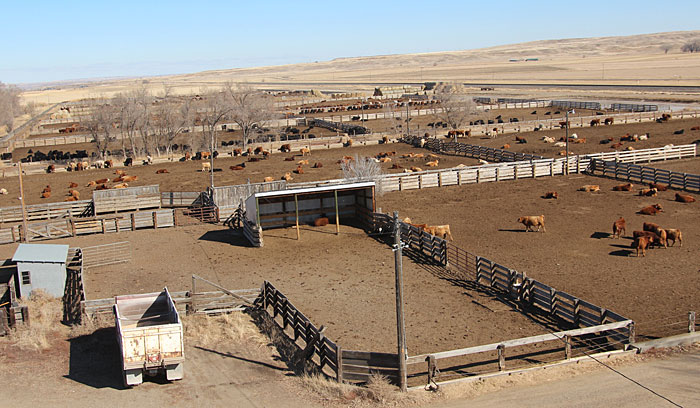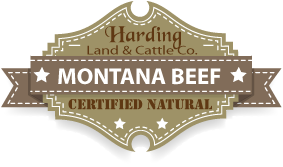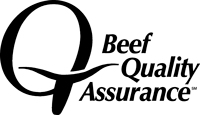The Harding Land & Cattle Company feedlot is an integral part of the operation as a whole. When one simplifies what Harding Land & Cattle Company is all about, there are really three interrelated facets of the operation: 1) the ranch 2) the farm 3) the feedlot.

The ranch produces grass for the nearly 1,000 head of mother cows that are there for much of the year, and supplies the operation with about the same number of calves that are ready to be weaned each fall. The farm produces alfalfa hay, corn silage and shell corn. These crops are then fed to the calves that are brought over to the feedlot each fall. In these terms, each of the three parts of this operation cannot function without the other ones.
The Harding Land & Cattle Company feedlot is both a background and a finishing feedlot. The calves raised by the Harding Land & Cattle Company operation are usually looking at reaching a slaughter time at about 14 to 16 months of age. In this respect, Harding Land & Cattle Company is a fully-integrated operation, which means that it owns the calves from the time they are born on the Harding Land & Cattle Company ranch, until the time they are ready to be sent to the neighboring USDA facility.
While they are being finished, the calves are fed a ration that includes corn silage, ground hay, shell corn and added supplements. The corn and hay crops come from the Harding Land & Cattle Company farm, and were harvested during the summer that is just coming to an end when calves start arriving at the feedlot.
In addition to bringing its own calves to the feedlot, the Harding Land & Cattle Company operation also feeds other producers’ calves as well. The feedlot capacity is somewhere around 2,000 calves, but rarely reaches those levels because there may be a combination of calves and cows present at the feedlot.
There are many responsibilities that come with managing a feedlot. The pens have to be cleaned of all the manure buildup. This is usually done in the summer when the pens are empty and the pens are at their driest point during the year. The manure is either piled outside the pens and spread on the farm fields later or spread on the fields when they are cleaned, depending on the time of the year and whether or not the crops have been harvested yet. Soil samples are taken to ensure that the rates of application of the manure are not exceeding certain limits.
Weather plays a big factor in managing the feedlot. During falls when the weather is hot and dry, the pens become very dusty, which can cause a multitude of health problems for the animals in the feedlot. In these cases, measures have to be taken to wet the pens down and minimize the dust. In the past, trucks with water tanks have been used in the pens to settle the dust. If cold, wet weather persists in the fall or winter, straw is usually spread in the pens to make the calves more comfortable.
When it comes to managing cattle in a feedlot, the less stress that the animals have to endure, the better. Less stressed animals perform better, remain healthier and gain more pounds per day, which are all benefits toward the operation’s bottom-line.
The handling of the livestock in the feedlot is also an important factor. Harding Land & Cattle Company’s feedlot conducts the handling of the livestock in such a manner that the animals are subjected to minimal stress. This is why it is so important to the operation to have gentle cattle. When a calf is sick and has to be pulled from a pen and treated, it is so much better for that calf, and the rest of the calves in the pen, if this can be done without exciting the animal.
Managing the bunks is possibly one of the most important duties during the months that the calves are at the feedlot. Being able to read a bunk in the morning and know whether certain portions of the ration need to be increased or decreased is very important. After a while, bunks accumulate a certain amount of left-over feed that the cattle would prefer not to eat. Therefore, the bunks are cleaned every so often, using shovels, in order to start over with a clean slate, so to speak.

